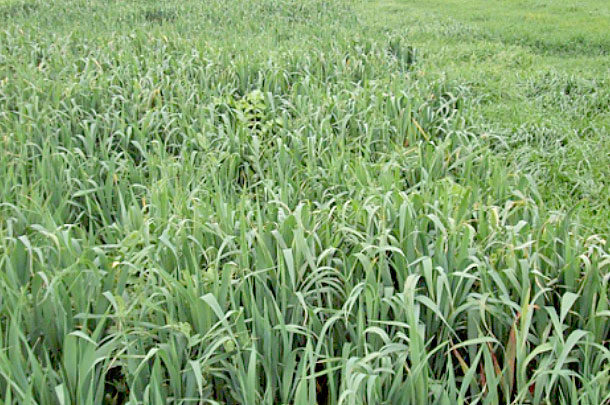Producers have many forage options that can be looked at as tools in their toolbox. Since every farm has different circumstances, there isn’t a “one-size-fits-all” forage option.
For the purposes of this article, alternative forage crops and rotations will refer to alternative to the traditional production practices of an individual farmer as well as alternative to a standard three-year rotation such as alfalfa, grass hay, corn or soybeans.
Adopting an alternative forage crop to replace an existing crop within your current rotation, for example, could be accomplished by replacing some corn acreage with a summer annual such as millet or forage sorghum. Alternative forage crops can be fit into rotations with cash grain crops, allowing for double cropping to gain more efficiency in land use. Additionally, many alternative forages can function as a cover crop as well as supplying forage.
The benefits of cover crops are well documented. Alternative forages are often used in a plastic-wrapping system, although a few of these crops can be dried under the right conditions. You may also consider adjusting your current rotation through length (three to five years, for instance) or number of crops grown (such as adopting the use of cover crops).
To provide an example, a rotation that includes a winter grain crop, such as winter wheat, allows many alternative forage options to be planted after the wheat is harvested. This could include summer annuals, such as sudangrass, that could be harvested for baleage before frost – or possibly oats, which are more cold-tolerant and could provide a forage harvest opportunity later in the fall.
Several legume species offer opportunities for forage harvesting after winter wheat harvest. For example, crimson clover and winter peas planted in late summer can provide forage the following year. Red clover is a short-lived perennial that can be used as a relay crop with winter wheat. It is frost-seeded into wheat during late winter and will grow rapidly in late summer after wheat harvest. Most years, this can provide a forage harvest opportunity in the fall as well as harvesting opportunities throughout the following growing season.
If you are considering whether to adopt an alternative crop or rotation in your forage cropping enterprises, make sure you have thoroughly considered your goals, requirements for the alternative, resources available, market opportunities and economic implications from the alternatives.
1. What are your goals?
As with any decision impacting your farm business, it should be related to a goal – what are you trying to achieve, and how does the decision impact your ability to progress toward that goal? Some goals you may have for incorporating alternative forage crops or implementing a new rotation include:
- Improve or maintain soil health and fertility, nutrients and structure
- Decrease pest pressure
- Control disease and weeds
- Gain more productivity from a limited land base
- Access a new market
- Improve production of other crops in the rotation
- Better meet livestock needs
- Control costs
Management goals and the paths used to achieve those goals will change over time and are going to vary depending on the specific situation of the farm, so don’t assume your adoption of an alternative forage crop or rotation to achieve a specific goal will, or must, look like that of another producer.
2. What are the requirements and resources available?
Prior to adopting a new crop or rotation, you should assess the production requirements for each alternative. You may find it helpful to connect with other farmers experienced with the crop or rotation you are considering. They will be well positioned to share with you their experiences and can guide you regarding aspects such as climate, soil composition and typography, water needs, and planting, cultivation and harvest considerations.
Assessing production requirements will also provide you the opportunity to assess whether you are faced with associated resource needs which you will need to determine whether you can meet. For instance, does a crop you are considering require a new piece of equipment or modifications to existing equipment? Will a new rotation require adjustments to production practices that require additional education/knowledge or labor practices?
Throughout your assessment of production requirements and resource needs, ensure you are tracking associated costs. This information will be needed when measuring the economic impact.
3. What are the marketing opportunities?
Accessing new markets with an alternative crop, as with economics, may not be a driving factor for adopting an alternative crop or rotation, but it is a factor you should familiarize yourself with. If you are marketing the crop itself, consider the number and accessibility of buyers, crop quality and characteristics buyers are looking for, prices or price premiums and any storage or transportation requirements. If you plan to feed your own livestock with the alternative crop, consider and investigate whether any markets exist that would provide a price premium for your feeding program.
An alternative rotation may also impact your marketing if buyers are depending on the ability to consistently source their forage needs from you on a certain schedule. You’ll need to determine whether buyers will be flexible and accommodating to the change you wish to adopt.
4. What is the economic impact?
Knowing and understanding the financial impact of any cropping change is an important piece of any management decision. While profitability of an alternative crop or rotation may not be your primary motivating factor, you should still understand the financial impact on your farm’s bottom line. Take full stock of input costs, yields and prices for the alternative crops. A useful tool for analyzing a change in crops or crop rotations is partial budgeting, as it allows you to look at only the changes in revenues and expenses associated with the change.
Something to keep in mind is that the true economic impact may not become known for several years. For instance, while you can determine the immediate return (or loss) from the adoption of a new crop at the end of the season upon harvest, when implemented within a rotation the full economic impact cannot be fully calculated until the complete rotation has occurred, which could be three, four, five years or longer.
Additionally, non-economic impacts may not be able to be assessed for even longer. For instance, if the adoption of an alternative crop or rotation is done for the purpose of improving soil conditions, the success of this change on the intended goal would not be known for possibly several years, and improvement of soil conditions would presumably also positively impact the other crops in the rotation through improved yields, better resiliency to adverse weather conditions or a decrease in major input costs, such as nitrogen.
5. Set the stage for success
Fully considering the questions outlined here prior to adopting an alternative crop or rotation can ensure you are well-positioned for success. In addition, growing a test plot or participating in research trials are two ways to become familiar with alternative forage crops and rotations before fully adopting them across your farm.
This article was co-authored by David W. Hartman, extension educator, Penn State Extension Livestock Team and Mary Barbercheck, department of entomology, Penn State.











